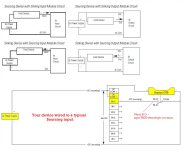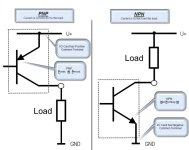Sinking and Sourcing Inputs and Outputs
That's correct bernie. NPN for a Sourcing input, and the "classical current sense" is how it should be read.
I think this might be getting very confusing for some here guys?
I haven't looked at the AutomationDirect explanation Tom, so forgive me if I repeat a lot of it.
This is the simplest explanation I can give as to how Sinking and Sourcing should be interpreted...
The terms Sinking and Sourcing specifically refer to the direction of the dc current, not the polarity of the voltage. I think this is where a lot of people get confused?
It is a simple dc circuit. The direction of the current is always from the +Vdc to the -Vdc. So when we say an input is Sourcing, it is Sourcing current to a field device. The field device in turn is switching that -Vdc back to the supply. This allows a current to flow from the +Vdc on the common of the input, through the input, out on the -Vdc and back to the supply. I think people mix this Sourcing up as referring to Sourcing voltage, and so think it should be +Vdc at the input? A Sourcing input is allowing current to flow in through the common +Vdc and out to the field device, so it must be a -Vdc.
However, by changing the polarity of the voltage, we can reverse the direction of the current. So if we use -Vdc at the input common, we require a +Vdc at the input terminal. This is now a Sinking current input. A +Vdc, from the supply, is wired to one side of the field device, which, when activated, switches the +Vdc to the input terminal. The current can now flow from the +Vdc of the supply, through the field device, into the input and back out on the -Vdc on the input common terminal, and back to the supply.
For either Sinking or Sourcing, an input does not care what direction the current is flowing, as long as enough current is detected to drive it high.
Likewise, an output does not care which direction the current is flowing. It merely supplies one side of the load to complete a circuit.
So for both an input, and an output, that support Sinking or Sourcing, they can pass +Vdc, or -Vdc.
Sinking and Sourcing also mean different things depending on which side you are looking from...
Field devices connected to the +Vdc of the field power supply are known as Sourcing field devices...
They are Sourcing current to a Sinking input by switching the +Vdc through themselves to the input...
So...
A Sinking input has a permanently connected -Vdc at its common. It requires a +Vdc from a Sourcing field device.
Field devices connected to the -Vdc of the field power supply are known as Sinking field devices...
They are Sinking current from a Sourcing input by switching the -Vdc from the input through themselves to the supply...
So...
A Sourcing input has a permanently connected +Vdc at its common. It requires a -Vdc from a Sinking field device.
So...
Sourcing Field Devices are used with Sinking Inputs...
The field device is on the positive side of the power supply between the supply and the input terminal. When the field device is activated, it sources current to the input circuit.
Sinking Field Devices are used with Sourcing Inputs...
The field device is on the negative side of the power supply between the supply and the input terminal. When the field device is activated, it sinks current from the input circuit.
Sourcing Field Devices are used with Sinking Outputs...
The field device is on the positive side of the power supply between the supply and the output terminal. When the output is activated, it sinks current from the field device.
Sinking Field Devices are used with Sourcing Outputs...
The field device is on the negative side of the power supply between the supply and the output terminal. When the output is activated, it sources current to the field device.
See attached diagrams...
To answer your questions...
Tofo said:
Does any relation between Sinking/Sourcing PLC inputs and NPN/PNP sensors?
Although they are widely used together, PNP and NPN sensors have no direct relation to Sinking and Sourcing input circuits. They are just a couple of the many devices you can connect to PLC inputs.
Also, just because a sensor says it is PNP or NPN, does not necessarily mean that their outputs switch positive or negative respectively. PNP and NPN merely refers to the type of transistor used inside the sensor. Positive (P-doped), and Negative (N-doped) semiconductor layers are used make up the transistor Base, Emitter and Collector. This electronic switch within the sensor does not always determine the polarity at the output. As mentioned, you can have 4 wire PNP and NPN sensors, which provide a N.O. or N.C. option. On some sensors you have to wire one of the output wires to -Vdc, or +Vdc as well to change the outputs polarity.
Tofo said:
...OK. Now I want to make sure that I understand correctly.
From what I understand from the replies, if I have a Sourcing Input PLC, I will need to connect a NPN sensor...
Your Sourcing input is Sourcing current to the Banner OTB. So a -Vdc is required between the input and the device, but the device, in this case, is
not an NPN sensor.
Tofo said:
...If that is correct, will my PLC detect Hi or Low when my NPN sensor detect something?...
...should I connect the NO or NC? and why? When I choose NO or NC, do I need to consider whether the PLC input is Sinking or Sourcing??
The Banner Optical Touch Button (OTB) is a photo-electric sensor, and
not a PNP or NPN sensor. It provides you with a dry Single Pole Double Throw (SPDT)
relay changeover contact. Because your input is Sourcing, you must connect -Vdc to the relay contacts Common terminal (Yellow).
You have to consider the input type as that will determine whether you need +Vdc or -Vdc on the relay Common. Again, you need -Vdc for your Sourcing input.
N.O. or N.C.? - You decide whether it's "
Hi or Low"...
If you want your input to only be TRUE when a finger is placed on the OTB, wire back to your input from the N.O. Contact (Black). If you want your input to be TRUE until a finger is placed on the OTB, then wire back to your input from the N.C. Contact (White).
Both contacts are switching the -Vdc from the relay Common.
Note: Wiring N.O. or N.C. does not make the Banner OTB PNP or NPN.
Just to hammer this home...
All devices that switch +Vdc to an input are not automatically called PNP, and all devices that switch -Vdc to an input are not automatically called NPN. They are only transistor types.
I Hope that's clear enough?
p.s. the OTB SPDT contact must switch a minimum dc load of 100mA. Your input may not provide a high enough load to cater for this. If not, I would suggest you drive an interposing relay from the OTB, and switch the -Vdc through that relay to your Sourcing input.
G.



